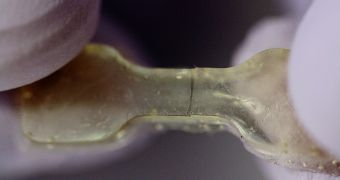We humans may not be as durable or tough as most of the things we build, but we do have the ability to heal, even though it's not quite as high as that of some animals. So self-healing technology has long been a goal of scientists. The dream is still somewhat out of reach, but that doesn't mean that progress isn't being made. It might not happen every day, or even every month, but it's happening.
Here is the latest step forward: a stretchy, self-healing polymer invented by scientists from the University of Illinois.
Often, when hearing the word “polymer,” our thoughts go to processing units and integrated circuits.
In this case, however, the polymer is actually a material most likely to be used in paints or plastic threads and objects with the ability to heal themselves.
Not really all that surprising really, since the polymer is made from a mixture of inexpensive commercially available compounds, like a polyurea elastomer. Polyurea itself is found in many paints and plastics.
The researchers call the sample “dynamic polyurea” and say that it was made by tweaking the structure of the molecules, making the bonds between them a little longer.
As a result, the molecules can be more easily pulled apart, but also able to bond back together much more easily.
In other words, they are more elastic and able to basically mold back into a seamless whole after being cut through. More or less.
All it takes is for the severed ends to touch for a day after being cut. They should be able to heal back together and recover most of the strength before the cutting, all this at room temperature. Heating things to 37ºC (98.6ºF) will speed the process up though. And all the while, no liquid-filled micro-capsules are used.
Other materials use them to basically glue severed edges back together, but that puts a limit on the ability to heal.

 14 DAY TRIAL //
14 DAY TRIAL //